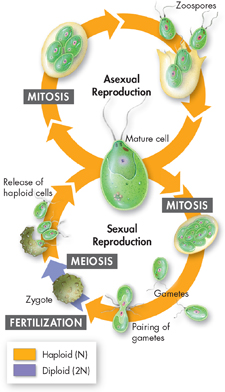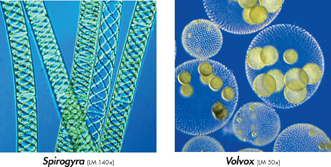Life Cycle Like land plants, many green algae have life cycles that switch back and forth between haploid and diploid phases. Some green algae may not alternate between haploid and diploid with each and every generation, however. Consider the single-celled green alga Chlamydomonas. It can stay in the haploid stage for multiple generations. As long as living conditions are suitable, the haploid cell reproduces asexually by mitosis, as shown in the top half of Figure 22–8.
If environmental conditions become unfavorable, Chlamydomonas can switch to a stage that reproduces sexually. The cell releases gametes that fuse into a diploid zygote—a sporophyte. The zygote has a thick protective wall, permitting survival in freezing or drying conditions that would ordinarily kill it. When conditions once again become favorable, the zygote begins to grow. It divides by meiosis to produce four flagellated haploid cells. These haploid cells then swim away, mature, and reproduce asexually.
 In Your Notebook Describe a more general advantage to an organism that can change its mode of reproduction under different environmental conditions.
In Your Notebook Describe a more general advantage to an organism that can change its mode of reproduction under different environmental conditions.

FIGURE 22–8 Life Cycle of Chlamydomonas The green alga Chlamydomonas can switch from asexual reproduction to sexual reproduction as environmental conditions change. Interpret Visuals Which form of reproduction includes a diploid organism that can survive harsh conditions?
dMulticellularity Many of the green algae form colonies, providing a hint as to how the first multicellular plants may have evolved. Two examples of colonial algae are shown in Figure 22–9. On the left is the freshwater alga Spirogyra, which forms long, threadlike colonies called filaments. The cells of a colony are stacked almost like soda cans placed end to end. The Volvox colonies shown on the right are more complex than those of Spirogyra, consisting of as few as 500 to as many as 50,000 cells arranged to form hollow spheres.
The cells in a Volvox colony are connected to one another by strands of cytoplasm, enabling them to communicate. When the colony moves, cells on one side of the colony “pull” with their flagella, and the cells on the other side of the colony “push.” Although most cells in a Volvox colony are identical, a few gamete-producing cells are specialized for reproduction. Because it shows some cell specialization, Volvox straddles the fence between colonial and multicellular life.

FIGURE 22–9 Multicellular Green Algae
Table of Contents
- Formulas and Equations
- Applying Formulas and Equations
- Mean, Median, and Mode
- Estimation
- Using Measurements in Calculations
- Effects of Measurement Errors
- Accuracy
- Precision
- Comparing Accuracy and Precision
- Significant Figures
- Calculating With Significant Figures
- Scientific Notation
- Calculating With Scientific Notation
- Dimensional Analysis
- Applying Dimensional Analysis




